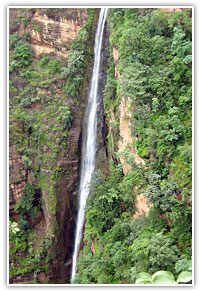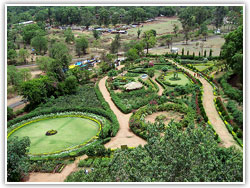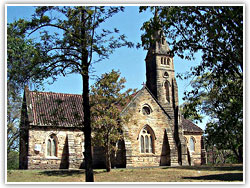|
|
Pachmarhi, Madhya Pradesh
.............................................................................................................................................................................. |
|
Information about Pachmarhi
Pachmarhi is Madhya Pradesh's most verdant jewel,
a place where nature has found exquisite
expression in myriad enchanting ways. Green shades
embrace the mountains, and everywhere is heard the
gentle murmur of flowing water. Bridle paths lead
into tranquil forest glades, groves of wild bamboo
and jamun, dense sal forests and delicate bamboo
thickets. Complementing the magnificence of nature
are the works of man. Pachmarhi is also an
archaeological treasure-house. In cave shelters in
the Mahadeo Hills is an astonishing richness in
rock paintings. Most of these have been placed in
the period 500-800 AD, but the earliest paintings
are an estimated 10,000 years old.
The year was 1857
when Captain James Forsyth of the Bengal Lancers
was galloping hard up the Satpura ranges. He
chanced upon this saucer-shaped valley
|
 |
|
|
and
recommended its development as a sanatorium. Churches
and cemetries bring back memories of the colonial past
of Pachmarhi which has managed to escape reckless
plunder suffered by other hill stations of India.
Pachmarhi can be visited throughout the year.
Tourist
Attractions in Pachmarhi
The various tourist attractions in Pachmarhi are
Priyadarshini, Jamuna Prapat, Handi Khoh, Apsara Vihar,
Rajat Prapat.
Priyadarshini (Forsyth Point)
This vantage viewing point marks the place from where
Pachmarhi was discovered by Captain Forsyth in 1857. The
British developed Pachmarhi as a resort and their
influence is embodied in its churches and colonial
architecture.
Jamuna Prapat (Bee Fall)
A spectacular fall in the stream which provides drinking
water to Pachmarhi. The bathing pools above the fall are
very popular.
Handi Khoh
Pachmarhi's most impressive ravine has a 300 feet high
precipice and dramatically steep sides.
Apsara Vihar (Fairy Pool)
Easily accessible from Jai Stambh, this 'fairy pool' is
an ideal picnic spot for families with small children,
since the pool is shallow, deepening only towards the
base of the fall.
Rajat Prapat (Big Fall)
Those seeking adventure will find it in this ten-minute
walk over rocks and boulders from Apsara Vihar to the
top of Rajat Prapat, the 'big fall'.
Irene Pool
This pool was discovered by Irene Bose, wife of Justice
Vivian Bose, and named after her. The route upstream
leads to a cave, through which the stream goes
underground and then over a khud in a series of falls.
Jalawataran (Duchess Falls)
The descent is steep and the trek strenuous for almost
all of the 4 km to the base of the fall's first cascade.
Sunder Kund (Saunder's Pool)
Crossing the stream below Duchess Fall and following a
footpath about 2.5 km in a south- west direction, brings
one to a huge rocky pool that is excellent for a
refreshing swim.
Mahadeo
Regarded as holy for countless of generations, Mahadeo
hill has a shrine with an idol of Lord Shiva and an
impressive Shivlinga. On the East side of the hill is an
excellent cave shelter with beautiful cave paintings.
Chhota Mahadeo
Revered as a sacred spot, this is a narrow point in the
valley with rocks overhanging a stream and a spring from
where water cascades down. |
|
|
|
Pandav Caves |
|
Five ancient
dwellings excavated in the sandstone rock in a low
hill. Pachmarhi derives its name from these caves
which, as the legend goes, once provided sanctuary
to the five Pandav brothers. These caves are now
protected monuments.
Tridhara (Piccadily Circus)
A popular picnic spot where two streams meet in a
junction.
Vanshree Vihar
(Pansy Pool) |
 |
|
|
A beautiful spot on
the Denwa stream, cool and shady among trees, ferns and
semi-tropical vegetation.
Reechhgarh
A wonderful natural amphitheater in the rock, approached
through a cave-like entrance on the South-side.
Sangam (Fuller's Khud - Waters Meet)
This is the lowest of the picnic spots on the Denwa and
offers fairly good bathing pools both below and above
the meeting of the waters.
Jata Shankar
A sacred cave under a mass of loose boulders in which
the Jambu Dwip stream has its source. A rocky formation
of this place resembles the matted locks of Lord Shiva,
hence the name.
Dhoopgarh
The highest point in the Satpura range, with a
magnificent view of the surrounding ranges. A very
popular spot for viewing sunsets.
Chauragarh
4 kms from Mahadeo, it is one of Satpura's prominent
land marks, the summit crowned with emblems of Mahadeo
worship.
Catholic Church
Built in 1892 by the British, the Catholic Church is a
blend of the French and Irish architecture. Its Belgium
stained-glass windows add rare attraction and beauty to
the building. The church has a cemetery attached to it
and graves date from 1859, World War I & II. |
|
|
|
Christ Church
Built in 1875 by the British, this Church's
architecture is fascinating; its
'sanctum-sanctorum' has a hemispherical dome on
top with its ribs ending with faces of angels. The
stained glass panes adorning the walls and rear of
the altar were imported from Europe. They present
a gorgeous view as the sun rays pass through them.
The nave of the church does not contain even a
single pillar for support. The baptismal font is a
rare brass piece and the bell is as old as the
church and |
 |
|
|
its chimes can be heard
from a long distance.
Satpura National Park
Set up in 1981, Satpura National Park is 524 sq km in
area. It spreads through dense forest of evergreen sal,
teak and bamboo. The high peaks of Dhoopgarh and Mahadeo,
Bori's legendary teak and bamboo forests, Pachmarhi's
fascinating natural beauty of deep valleys, high
mountains, rivulets, waterfalls and Tawa's vast
reservoir combine to give this park unique beauty and a
breathtaking variety of attractions. The park is home to
the bison, tiger, Leopard, bear, four-horned deer,
blue-bull and a rich variety of birds.
Bison Lodge
Constructed in 1862, the Bison Lodge is the oldest house
in Pachmarhi. It now houses a beautiful museum depicting
the rich flora and fauna of Pachmarhi.
The Cave Shelters
Some of the best cave shelters and groups of shelters
around Pachmarhi are: Dhuandhar, approached from the
footpath to Apsara Vihar, the paintings mostly in white
include a group of archers with the typical Gond bun and
hooped earrings. Bharat Neer (Dorothy Deep), has well
executed animal paintings and when excavated in the
1930s yielded many pottery shards and microliths.
Asthachal (Monte Rosa), there are four shelters with
paintings, comparatively early linear drawings. Along
the northern side of Jambu Dwip valley are some six
shelters with many paintings of animals and human
figures, including a detailed battle scene. Harper's
Cave, so named because of one of its paintings - a man
seated and playing a harp is close to the Jata Shankar
Shrine. The Chieftain's Cave derives its name from a
battle scene showing two chieftains on horses. A terrace
that runs the length of the South, South East and East
faces of Kites Crag has some fine cave paintings, the
majority of which are in white or outlined in red.
How to reach Pachmarhi
By Air
The nearest airport is located at Bhopal, about 195 kms.
connected by regular flights with Delhi, Gwalior,
Jabalpur, Indore and Mumbai.
By Rail
Pipariya, about 47 kms., on the Mumbai-Howrah mainline
via Allahabad, is the most convenient railhead.
By Road
Pachmarhi is connected by regular bus services with
Bhopal, Hoshangabad, Nagpur, Pipariya and Chhindwara. |
|